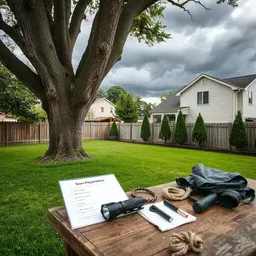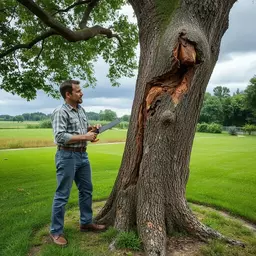Long-Term Tree Risk Management Tips

In a world where trees are vital to our environment and well-being, understanding how to manage tree risks is more crucial than ever. Did you know that proactive tree risk management can not only safeguard your property but also enhance community health?
What You Will Learn
- Tree risk management is a long-term commitment that enhances safety and fosters a healthier environment.
- Regular risk assessments are essential for identifying potential hazards before they escalate into emergencies.
- Sustainable practices, such as proactive tree care, not only reduce costs but also benefit the ecosystem.
- Community engagement through educational workshops and group tree care days promotes awareness and responsibility.
- Climate change impacts tree health, necessitating adaptive risk management strategies to protect urban forestry.
- Successful case studies demonstrate the effectiveness of long-term management plans in enhancing tree safety and community involvement.
- Urban forestry practices can significantly improve air quality, reduce heat, and enhance property values in communities.
Key Benefits of Sustainable Tree Risk Practices
Understanding the importance of sustainable practices in tree risk management enables homeowners to enjoy safer outdoor spaces.
Enhanced Safety
Regular maintenance reduces the chances of accidents caused by falling branches or uprooted trees.
Environmental Benefits
Healthy trees help improve air quality, provide shade, and support local wildlife.
Cost Savings
Proactive care can prevent costly emergency tree removals and damage repairs.
Risk Assessment
Regular evaluations help identify potential hazards before they become emergencies.
Preventive Actions
Taking steps to mitigate risks—such as pruning or cabling—can significantly enhance safety.
Emergency Preparedness
Having a plan in place for storm events or other emergencies is crucial for protecting your home and family.
Understanding Long-Term Tree Risk Management
Managing tree risk is more than just a seasonal task; it’s a long-term commitment to the safety and well-being of your property and family. At Safe Canopy Care, we believe that understanding the complexities of tree risk management is essential for every homeowner. By implementing sustainable practices, we can help ensure that our trees remain healthy and serve as valuable assets rather than hazards.
One of the best ways to think about tree risk management is to view it as a proactive approach. Rather than waiting for a storm to highlight vulnerabilities, it’s important to regularly assess and address potential risks. This not only protects your home but also fosters a healthier environment for the trees we cherish.
The Importance of Sustainable Tree Risk Practices
Sustainable tree risk practices are crucial for maintaining a balance between nature and urban living. By focusing on sustainability, we can ensure that our landscaping contributes positively to the ecosystem while mitigating risks associated with tree hazards. Here are some key benefits of adopting sustainable practices:
- Enhanced Safety: Regular maintenance reduces the chances of accidents caused by falling branches or uprooted trees.
- Environmental Benefits: Healthy trees help improve air quality, provide shade, and support local wildlife.
- Cost Savings: Proactive care can prevent costly emergency tree removals and damage repairs.
Incorporating these practices into your tree care routine can lead to a safer, more enjoyable outdoor space. I encourage all homeowners to take a moment and consider how their tree management practices can support sustainability.
Defining Tree Risk Management and Its Impact on Safety
Tree risk management involves assessing the condition of trees and the risks they may pose to people and property. It’s essential to recognize that not all trees are created equal. Their health, location, and surrounding conditions all play a role in determining their risk level. One of the smartest steps homeowners can take is ensuring they hire qualified professionals and using a tree service directory, is an excellent way to find trusted, certified experts. Here are some vital aspects of tree risk management:
- Risk Assessment: Regular evaluations help identify potential hazards before they become emergencies. For further guidance, the International Society of Arboriculture (ISA) provides resources on basic tree risk assessment.
- Preventive Actions: Taking steps to mitigate risks—such as pruning or cabling—can significantly enhance safety.
- Emergency Preparedness: Having a plan in place for storm events or other emergencies is crucial for protecting your home and family. The Arbor Day Foundation offers insights on assessing tree risk and preparedness.
By understanding the elements of tree risk management, homeowners can create a safer environment for their loved ones. At Safe Canopy Care, we emphasize education and communication about these risks, empowering our clients to make informed decisions.
Urban Forestry and Its Role in Risk Management
Urban forestry plays a significant role in tree risk management, especially in populated areas where trees face unique challenges. By managing the urban forest effectively, we can reduce risks and enhance the benefits that trees provide. Consider these key points:
- Tree Selection: Choosing the right species for urban settings is essential for long-term health and safety.
- Community Involvement: Engaging local communities in tree care fosters stewardship and awareness.
- Policy Development: Implementing citywide tree management policies can streamline care and promote healthy growth. Purdue University Extension offers valuable information on managing trees for public safety.
As a tree safety expert, I’ve seen firsthand the importance of integrating urban forestry principles into our risk management strategies. Together, we can cultivate a thriving community of healthy trees that add beauty and safety to our neighborhoods.
Pro Tip
Did you know? Regular tree inspections can save you up to 50% on emergency tree removal costs! By staying ahead of potential issues through routine assessments and maintenance, you not only save money but also enhance the safety and longevity of your trees.
Addressing Emerging Trends in Tree Risk Management
As we navigate the ever-evolving landscape of tree risk management, it's crucial to stay informed about emerging trends that impact our strategies and approaches. At Safe Canopy Care, I've observed that understanding these trends not only enhances tree safety but also strengthens our connection with the community. Let's explore how climate change, community engagement, and successful case studies play vital roles in shaping our practices.
One significant trend is the impact of climate change on tree health. Rising temperatures, altered precipitation patterns, and extreme weather events pose new challenges for trees and their surroundings. This means that we must adapt our risk assessment practices accordingly. Consider these factors:
- Increased pest and disease prevalence due to warmer climates
- Higher risks of tree failure during storms
- Changes in soil health affecting root stability
By recognizing and addressing these climate-related challenges, we can develop more effective risk management strategies that protect both trees and property.
Impact of Climate Change on Tree Health and Risk Assessment
Climate change is not just a distant concern; it directly affects the health of our trees today. For instance, certain tree species may struggle to adapt to the changing climate, leading to weakened structures and increased vulnerability. This makes regular assessments even more critical! Here are some ways to assess the impact:
- Monitor tree health indicators like leaf discoloration and premature leaf drop.
- Evaluate soil moisture levels to ensure roots are receiving adequate water.
- Identify signs of pest infestations that may thrive in warmer climates.
By closely monitoring these factors, we can stay ahead of potential risks and ensure our trees remain healthy and resilient.
Fostering Community Engagement for Effective Risk Management
At Safe Canopy Care, we believe that community engagement is essential for effective tree risk management. When communities come together, we can share knowledge, resources, and support one another in maintaining tree safety. Here are some ways to foster engagement:
- Host educational workshops focused on tree care and safety.
- Encourage neighborhood tree care days for hands-on learning.
- Utilize social media platforms to share tips and success stories.
Engaging with the community not only builds awareness but also cultivates a culture of proactive tree care, which benefits everyone.
Case Studies: Successful Implementation of Long-Term Management Plans
Learning from successful case studies can provide valuable insights into effective tree risk management. For example, a community in my area implemented a long-term tree management plan that focused on routine inspections and community education. This led to the following outcomes:
- Reduced tree-related accidents and property damage during storms.
- Increased community participation in tree care initiatives.
- Enhanced overall tree health and aesthetics in public spaces.
These successes highlight the importance of being proactive and working together toward common goals.
Environmental Impact of Urban Forestry Practices
Urban forestry practices have a profound impact on both the environment and our communities. Trees play a crucial role in enhancing air quality, providing shade, and supporting local wildlife. As we embrace urban forestry, we should consider these benefits:
- Trees reduce urban heat islands, making cities cooler.
- They improve stormwater management by absorbing excess rainfall.
- Urban forests enhance property values and community pride.
By investing in urban forestry, we contribute to a healthier environment and a brighter future for our neighborhoods.
Frequently Asked Questions About Tree Risk Management
- What is tree risk management?
- Tree risk management involves assessing the condition of trees and the potential hazards they might pose to people and property. Its goal is to identify, evaluate, and mitigate these risks to ensure safety and preserve urban green spaces.
- Why are regular tree risk assessments important?
- Regular risk assessments are crucial for identifying potential hazards like weak branches, disease, or structural instability before they escalate into emergencies. Proactive assessments help prevent accidents, property damage, and costly emergency removals.
- How does climate change affect tree health and risk?
- Climate change, with its rising temperatures, altered precipitation, and extreme weather events, can weaken trees, increase their susceptibility to pests and diseases, and raise the risk of tree failure during storms. This necessitates adaptive risk management strategies.
- What are the benefits of sustainable tree risk practices?
- Sustainable practices lead to enhanced safety by reducing accident risks, provide environmental benefits like improved air quality and wildlife support, and result in cost savings by preventing expensive emergency tree work.
- How can communities get involved in tree risk management?
- Community engagement can be fostered through educational workshops, neighborhood tree care days, and using social media to share tips and success stories. This involvement promotes awareness, fosters stewardship, and supports proactive tree care.
Conclusion and Next Steps for Tree Risk Management
In conclusion, effective tree risk management requires a comprehensive understanding of emerging trends, community engagement, and successful case studies. By staying proactive and educated, we can ensure the safety and health of our trees. At Safe Canopy Care, I'm committed to empowering homeowners and property managers with the knowledge they need to protect their outdoor spaces.
Now, I encourage you to take action! Whether it’s signing up for our Tree Safety Essentials Checklist or engaging with your neighbors on tree care initiatives, every step counts. Together, we can cultivate safer, healthier environments for ourselves and future generations.
Recap of Key Points
Here is a quick recap of the important points discussed in the article:
- Proactive Tree Risk Management: Regular assessments and preventive actions ensure tree safety and health.
- Sustainable Practices: Implementing sustainable tree care enhances safety, provides environmental benefits, and results in cost savings.
- Community Engagement: Involving the community in tree care initiatives fosters stewardship and enhances awareness of tree risks.
- Impact of Climate Change: Stay informed about climate-related challenges affecting tree health and adjust risk management strategies accordingly.
- Urban Forestry Benefits: Effective urban forestry practices improve air quality, manage stormwater, and enhance property values.
Popular Posts
 As homeowners, understanding the potential dangers storms pose to our landscapes can be the differen
As homeowners, understanding the potential dangers storms pose to our landscapes can be the differen
 What if your seemingly intact tree holds hidden dangers? After a storm, many homeowners overlook the
What if your seemingly intact tree holds hidden dangers? After a storm, many homeowners overlook the
 Have you ever thought about the hidden dangers that trees on your property might pose? While they pr
Have you ever thought about the hidden dangers that trees on your property might pose? While they pr
 As storms become more frequent and severe, the safety of your property and loved ones relies heavily
As storms become more frequent and severe, the safety of your property and loved ones relies heavily
